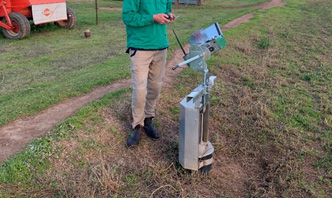Sensing and automating
There are lots of different technologies that can be used to capture data and automate repetitive tasks. Common examples on farms include weather stations and electronic identification devices, and they all rely on three pieces of equipment:
- The sensor, any device used to collect information.
- A network to transmit the data, either wireless or wired.
- A computer or software to read the data, either remotely or on the device.
Sensors
Sensors can detect outputs such as light, moisture and speed. Commonly used sensors include:
- Location sensors used in GPS satellites to triangulate a position, giving quick and reliable data. These are often found in guidance systems on machinery.
- Temperature, wind speed and direction, humidity and rainfall sensors that collect data for weather stations.
- Moisture sensors in probes used to check water levels in soil profiles.
- Electrical current sensors used to monitor electric fences for faults and breakages.
The data these sensors generate, or store, has little value unless it can be converted into meaningful information to support farmers with day-to-day tasks and strategic decisions to make their business more efficient and productive.
In most cases, the data must be transmitted to a device or software to be analysed. For example, electronic identification devices such ear tags on sheep must be scanned by a device to read the information.
Whereas soil moisture or weather data must be analysed by a computer either on the device itself or transmitted via a network.
Networks such as Bluetooth, mobile phone and LoRaWAN make this possible by transmitting the collated data. This means farmers can use the data to make decisions from almost anywhere, even when they are not on the farm. For example, a farmer with an weather station can have the data sent to a device to be stored. This saves time manually checking rain gauges and is useful when analysing historical weather patterns.
Automation
Automation is the ability to undertake a task remotely.
To program a device to automate a process you will need to use either an application on your phone or a web-based interface available through your web browser.
Auto-drafting or walk-over weighing of livestock is an example of how automation works on a farm. The computer reads the animal’s NLIS electronic ear tag, analyses the data, and then drafts the animal to a particular pen.
In the photo below a farmer is programming one of his auto-winches, used in bay irrigation, to open and close automatically via an app on his mobile phone.
